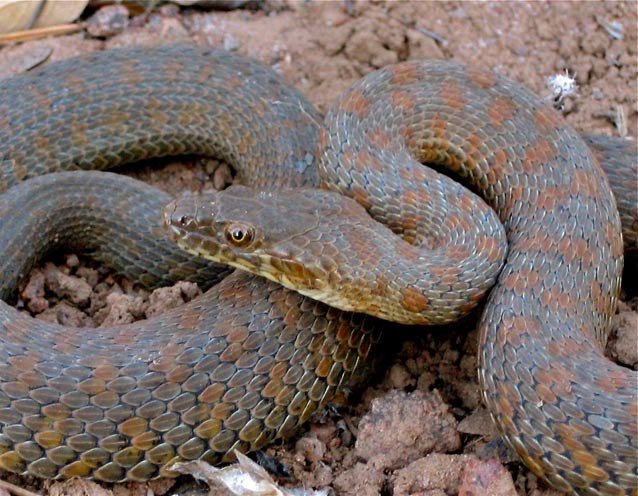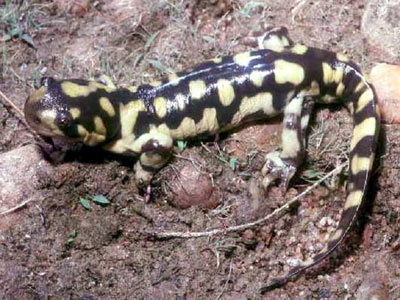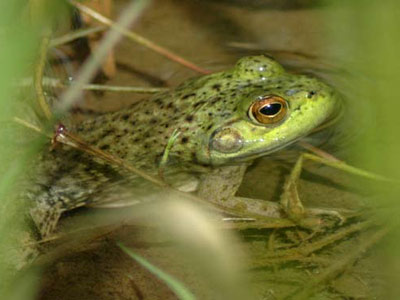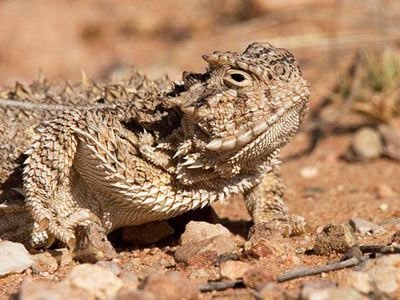Declines in amphibian and reptile populations have been and are being observed. Herpetofauna across the globe face threats from both known and unknown sources (Gibbons et al. 2000). Disease may now be as great a cause of amphibian decline as habitat destruction. Potential causes of herpetofauna decline in the Southwest include habitat loss and degradation, direct persecution, disease, invasive species, chemical contamination, ultraviolet radiation, drought, and illegal collecting.
Habitat Loss and Degradation
Habitat loss and degradation is one of the greatest threats to amphibian and reptile populations and occurs from a variety of sources, including urban/suburban development, aquatic habitat alteration from water withdrawals and stream diversions, water pollution, and off-road vehicle use in terrestrial habitats. Declines in both population levels and species diversity have been attributed to habitat loss and degradation. Development can negatively affect habitat by destroying sites or degrading their quality, and by creating barriers or hazardous zones (e.g., a road) between important habitat features. Loss and degradation of habitat can disrupt population connectivity, diminishing the rate of dispersal and recolonization, such that local populations are unable to persist through natural catastrophes or population fluctuations.
For amphibians and aquatic reptiles (e.g., Mexican and narrow-headed gartersnakes [Thamnophis rufipunctatus]), the destruction of wetlands removes breeding sites and fragments populations, making these species more vulnerable to regional extirpation. For semi-aquatic and terrestrial reptiles, similar declines may occur. For example, individual desert tortoises occasionally move long distances between populations (Edwards et al. 2004). Historically, populations exchanged individuals at a rate > 1 migrant/generation. Such movements today are increasingly difficult for tortoises due to fragmentation of their habitat from landscape changes such as roads, housing developments, canals, and fences. Also, the loss of native bunchgrasses, from cattle grazing, in the Chiricahua mountains in southeastern Arizona was considered to be the main cause of a decline in the bunchgrass lizard (Sceloporus scalaris) (Ballinger and Congdon 1996). This lizard requires bunchgrasses for cover and protection from predators and harsh winter conditions.

Dustin A. Wood / USGS
Many studies have reported high rates of amphibian and reptile mortality on roads. Amphibian populations are most susceptible to high rates of road-kill when migrating en masse between habitat patches. Reduced anuran (order in the class Amphibia that includes frogs and toads) density and population abundance, lower probabilities of occurrence, and adverse population genetic effects have been attributed to roads. Reptiles, such as snakes, sometimes prefer sunning on warm, smooth surfaces such as roads. A year-long study in a Texas wildlife management area found road traffic affected reptiles extensively in the fall and spring and amphibians in the spring and summer. In the spring, 83% of amphibians observed were found dead on the road (Coleman et al. 2008). Road mortality in Arizona is also high during the summer rain (monsoon) period, when amphibians are drawn to breeding sites and some snake breeding movements are also high.
Urban development also increases conflicts between venomous species and humans (Sullivan et al. 2004, Nowak et al. 2002). Every year in the Tucson and Phoenix, Arizona, areas, hundreds of rattlesnakes and dozens of Gila monsters are removed from residential/human-inhabited areas and translocated to nearby desert habitats. Research, however, has shown that some translocations may not be effective in removing the animal from the original area and/or may subject translocated animals to increased risks (e.g., from predation).
Wildfires may also lead to long-term or permanent loss of habitat for amphibians and reptiles. Such loss includes the filling-in or sedimentation of stream pools. In SAGU, many tinajas (bedrock pools) that are home to the lowland leopard frog have been buried by eroded material resulting from stand-replacing widlifes occurring at higher elevations (Parker 2006).
Diseases
Chytridiomycosis
The disease chytridiomycosis is caused by a recently identified species of parasitic fungus (Batrachochytrium dendrobatidis), known as the amphibian chytrid fungus. Chytridiomycosis is considered a major threat to amphibians worldwide, causing population declines and species extinctions. The disease is thought to have originated in Africa, spreading rapidly since the 1970s (Australia Department Environment and Heritage 2006), although this is debated and much is still unknown about the disease.
Amphibian chytrid fungus attacks keratin in the skin of amphibians. The water-dependent fungus spreads via free-swimming zoospores, which colonize amphibian skin and develop into zoosprangia. The fungus is believed to be able to persist in aquatic environments without amphibians. Amphibian larvae are not lethally affected, but they can carry the fungus in mouthparts and toe tips during later stages of development. Some amphibian species can carry the fungus without being killed by it, and they may serve as vectors of the pathogen to more susceptible species.
The responses of amphibian populations infected with the fungus range from no perceptible impact, to mass mortality events, to severe decline without recovery. In the western U.S., chytridiomycosis is thought responsible for the decline of the boreal toad in the southern Rocky Mountains, and for the recent, catastrophic decline of this species in Rocky Mountain National Park. Reports of the disease in the Southwest include infections in lowland leopard frogs (Lithobates yavapaiensis), Chiricahua leopard frogs (Lithobates chiricahuensis), and canyon tree frogs (Hyla arenicolor) in eastern, central, and southern Arizona (Bradley et al. 2002). The disease may persist in healthy amphibian populations once an epidemic wave has passed.

Colorado Parks and Wildlife
Ranavirus
The genus Ranavirus (family Iridoviridiae), only recently discovered, causes disease in amphibians, reptiles, and fish. Amphibian ranaviruses are considered a global threat to amphibian populations due to their high virulence and rapid expansion to areas with previously unexposed populations. Ranavirus is associated with mass mortalities in amphibians, particularly larvae and recently metamorphosed juveniles, with death rates reaching 100%. Death is thought to result from organ failure due to tissue necrosis and possibly from secondary bacterial infections. Ranavirus can be spread in various ways, including through infected food, water, human handling, introduction of fish and amphibians (e.g., released bait and pets), and boats and fishing gear. The disease is thought to be particularly associated with disturbed or degraded habitats and high amphibian densities. Susceptibility to disease may be influenced by many factors, including chemical exposure and temperature. Ranavirus has not been shown to cause local or species extinctions, but because ranavirus outbreaks sometimes kill all or most of an entire year class in a population, the persistence of local amphibian populations could be threatened by episodic die-offs. A virus thought to be an iridovirus was found to be the primary cause of periodic population crashes in the Sonora tiger salamander (Ambystoma tigrinum stebbinsi) in southern Arizona (Jancovich et al. 1997).
Upper Respiratory Tract Disease
Another disease of concern for reptiles is a widespread upper respiratory tract disease (URTD) caused by the bacterium Mycoplasma agassizii (Gibbons et al. 2000). This contagious disease may be part of the cause of population declines in desert tortoises (Gopherus agassizii) in the Mohave Desert (Ivanyi et al. 2000); in Arizona, most populations of the tortoise do not seem to be impacted by this disease. In addition to desert tortoises in the Mohave Desert, M. agassizii has been identified in Florida gopher tortoises and box turtles (Pappas 2003). Symptoms of the disease are a runny or wet nose and eyes. The disease is spread by direct contact and probably by an infected animal sneezing and leaving drops of muscous. Captive tortoises should not be released into the wild, because, among other reasons, they could spread M. agassizii or other diseases.
Invasive Species

© Kelly Mcallister
Non-native invasive species are another threat to amphibian and reptile populations. Non-native invasive species may act as predators of or competitors with native species. Bullfrogs (Lithobates catesbeianus), for example, were introduced in the 1800s west of the Rocky Mountains, where they are efficient predators of amphibians and some reptiles (Marks 2006). For example, the bullfrog is thought to be a primary cause of declines of leopard frogs (including the federally-threatened Chiricahua leopard frog) and gartersnakes in Cochise County, southern Arizona (Rosen and Schwalbe 2002). Few young Mexican gartersnakes (Thamnophis eques), a highly aquatic species, were found to survive in the presence of bullfrogs, but the snakes may survive well once they outgrow the sizes susceptible to bullfrog predation.
Non-native fish are also a major problem for native aquatic amphibians and reptiles. Non-native fish compete with or eat native fish that are needed by the herpetofauna species, such as narrow-headed (Thamnophis rufipunctatus) and Mexican gartersnakes. For example, research by the U.S. Geological Survey found that the distribution pattern of narrow-headed garter snakes in Oak Creek, Arizona, was similar to the availability of smooth-bodied fish with soft fins (a major food source) (Nowak 2006a). The snakes may be declining in the lower reaches of the creek, which are dominated by unedible, non-native fish with stiff, spiny fins. Non-native fish may also prey upon native amphibians and reptiles.
Non-native crayfish in the Southwest have caused the decline of some amphibian and aquatic reptile species (Marks 2006). Crayfish, such as the Northern or virile crayfish (Oroconectes virilis), intentionally introduced for bait and vegetation control, eat insects, fish, frogs, small snakes, and young turtles (Arizona Invasive Species Advisory Council 2008). Crayfish populations increase dramatically while the native herpetofauna and other prey decrease; crayfish then consume the aquatic plants present, altering the aquatic communities where they are found. Victims of the non-native crayfish include the narrow-headed gartersnake (Nowak 2006a), whose young and prey are eaten by the crayfish.
The introduction of non-native plant species threatens some reptiles. Alteration of habitat (e.g., changes in habitat structure and native plant community composition) has negatively affected the desert tortoise (Gopherus agassizii) (Gibbons et al. 2000, Ivanyi et al. 2000). In Arizona, exotic annuals such as red brome (Bromus rubens) and buffelgrass (Pennisetum ciliare) have increased, and native perennial grasses, shrubs, and annuals have decreased. These changes are detrimental because the tortoise and other species require the native vegetation, and because the proliferation of the exotics has led to increased fire frequencies in areas where many of the plants are not well-adapted to fire (Esque 2003). Tortoises are also directly killed by fire.
Chemical Contamination
Chemical contaminants come from many sources and include locally applied herbicides, pesticides, and fertilizers, wastewater, and unintended releases of sewage, fuels, solvents, and other chemicals used for maintenance or construction. Such pollutants can have direct and indirect effects on both amphibians and reptiles (Gibbons et al. 2000). Amphibians may be exposed to chemical hazards through direct uptake from water or by ingestion of contaminants in soils, sediments, and food items. They may be unusually susceptible to toxins due to their permeable skin and protracted development in the aquatic environment. Many aquatic snakes, such as the narrow-headed gartersnake, and other aquatic/semi-aquatic reptiles may also be susceptible to contaminants. Knowledge about the effects of contaminants on amphibians is scarce, and reptiles have been studied even less (Gibbons et al. 2000) Effects of contaminants on reptiles are known primarily from observations on turtles and crocodilians.
The variety and severity of sublethal effects indicated by controlled studies suggests the potential for contaminants to affect amphibian populations. Chemical stressors, even at levels well below toxic concentrations, influence the ability of amphibians to handle environmental stress. The interaction of physical and chemical stress is an important area of research about amphibian population declines.
Ultraviolet (UV-B) Radiation
Because pollutants have reduced the thickness of the protective ozone layer in the atmosphere, increasing amounts of UV-B are reaching the earth’s surface. UV-B levels have increased an estimated 5-10% per decade since 1979, especially at higher latitudes and in early spring. Amphibians may be more vulnerable to harmful effects of UV radiation than other kinds of animals due to their “naked” skin and shell-less eggs. [An increase in UV-B radiation levels is unlikely to threaten reptile eggs at this time, because they are infrequently exposed to UV-B radiation (Gibbons et al. 2000)].
Adverse effects of UV-B include interference with intracellular functions, impaired transcription of DNA, and interactions with chemicals that make them more toxic. Field and laboratory studies have demonstrated increased mortality, deformities, and susceptibility to fungal disease. There is debate over whether or not UV-B is a main factor in currently observed amphibian declines, but researchers share concern about ozone depletion and the consequences of increasing levels of UV-B. Of particular concern is the potential for UV-B to interact in complex ways with contaminants, climate (e.g., drought), and disease.
Drought

© Robert Shantz
Amphibian and reptile populations are sensitive to fluctuations in the amount and timing of precipitation. Drought has been implicated as the cause of drastic declines in frog populations. In addition to direct effects on survival and reproduction, drought can adversely affect amphibians by interacting with other factors, such as disease, UV-B radiation, and exposure to contaminants. Although drought is a natural phenomenon, climate changes including drought could be occurring faster than organisms can adjust. Climate change is cited consistently as one of the main potential causes of amphibian population declines. Temperatures have increased 0.8 degrees celcius in the West since the 1950s, and they are predicted to rise 2-5 degrees in the next century (Hansen et al. 2001). Drought frequency is predicted to increase by 66-90% (Gitlin et al. 2006).
Drought adversely affects amphibians because of their dependence on pooled surface water for reproduction. When a breeding pond dries up prior to the onset of metamorphosis, the entire reproductive effort for the year is lost. At ponds reduced in size because of drought, an increase of larval density can negatively influence larval survival by slowing development. In addition, pond drying can result in early metamorphosis, which is linked to small body size and decreased survival rates in juvenile frogs. Post-metamorphic amphibians which use terrestrial habitats for non-breeding activities can also be adversely affected by drought. The loss of body water through evaporation must be offset through absorption of water from wet or moist substrates. Amphibians must rehydrate frequently; death results from desiccation. Amphibians crowded into limited habitat also may be more subject to disease or parasite epidemics.
Drought impacts desert reptiles because there is less free water for them and their prey. Prey numbers typically decline during drought, and many reptiles rely on their diets to obtain water if they cannot drink free water; they may die from dessication if they cannot eat enough. A behaviour of some reptiles, which may be especially important for survival in the desert where rainwater may not accumulate (Repp and Schuett 2008), is that of harvesting and drinking water from their own bodies (e.g., from a pool of water within a snake’s coils). Repp and Schuett (2008) reported on western diamond-backed rattlesnakes (Crotalus atrox) harvesting and drinking rainwater in the Sonoran Desert during an extended drought.
Other Potential Threats

Colorado Parks and Wildlife
Increased temperatures resulting from climate change could affect some reptiles and amphibians. Evidence for effects on freshwater turtles includes increased juvenile growth rates, earlier ages at maturity, and changes in sex ratios (Frazer et al. 1993). Crocodilians and some turtles may be affected the most, because of their temperature-dependent sex determination. Altered sex ratios could affect population demographics and persistence. Reptiles and amphibians could also be affected by climate change if changes occur in hibernation periods. The absence of a long hibernation period could result in starvation over the winter or changes in gonadal development. An increase in summer temperatures could render burrows unusable and result in dessication. Illegal collecting of herpetofauna in the Southwest may also affect some populations. For example, illegal collecting for the pet trade may be the biggest threat to twin-spotted rattlesnake (Crotalus pricei) populations in the U.S. at the present time (Prival et al. 2002); this species occurs in the U.S. only in four disjunct mountain ranges in southeastern Arizona. Reptile collecting may also lead to the destruction of habitat, which can further adversely affect populations (Goode et al. 2002). To expose reptiles in their shelters, collectors break apart and overturn rocks; this usually leads to permanent damage of cracks and crevices that serve as shelters in the rock outcrops.
In addition to the threats from non-native, invasive species discussed in the last section, domestic animals, such as dogs, may also threaten some reptile species. The impacts of free-roaming domestic dogs on the desert tortoise have been studied at SAGU and found to be an issue (Zylstra 2008). Also, in a small (<30) tortoise population in Tucson that is surrounded by urban development, many of the individuals show shell trauma from domestic or feral dogs (Edwards et al. 2004).
Prepared by Patricia Valentine-Darby, Southern Plains Network Inventory and Monitoring Program, 2010.
Part of a series of articles titled Reptiles and Amphibians of the American Southwest.
Last updated: May 20, 2015
